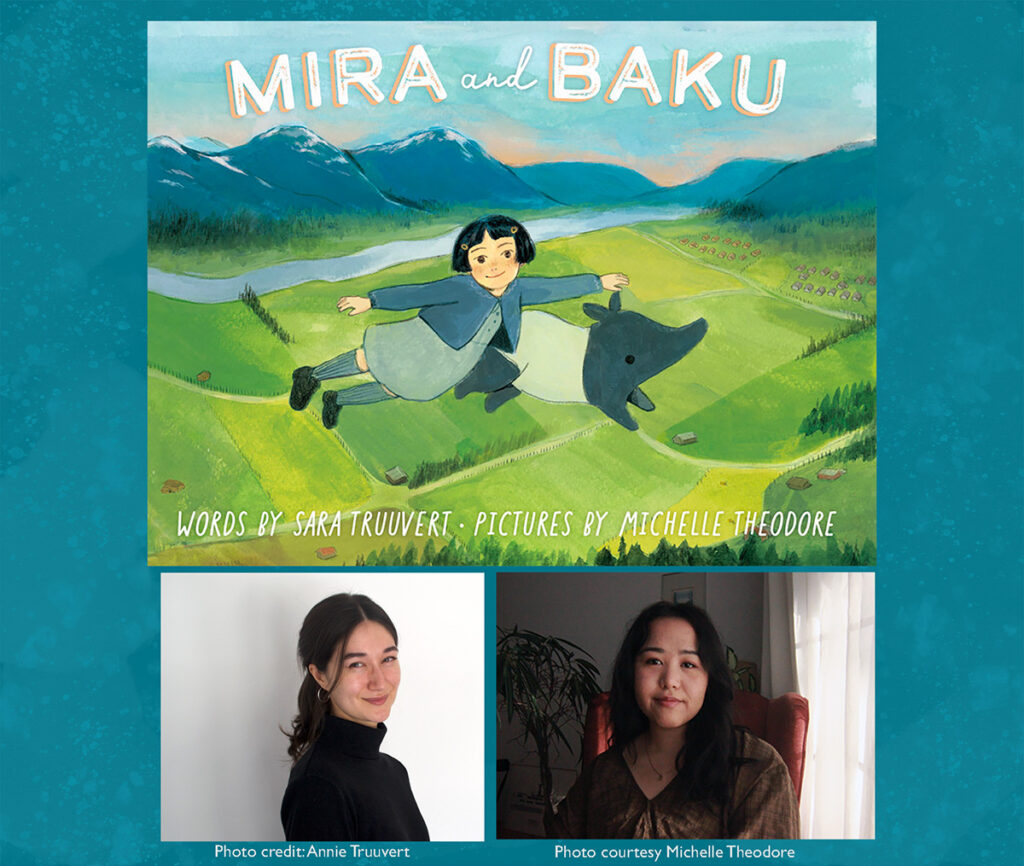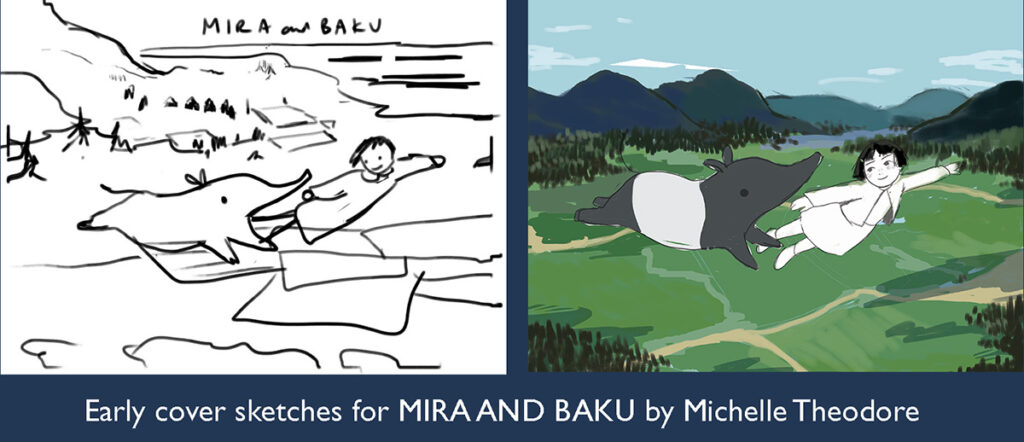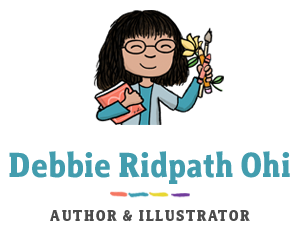
Sara Truuvert is the author of Mira and Baku, her debut picture book, published by Annick Press. Sara’s short fiction and poetry have appeared in publications like Ploughshares, the Chicago Quarterly Review, Witness, and PRISM international. She lives in Ontario. You can find her at saratruuvert.com.
Michelle Theodore is an illustrator born and raised under the prairie skies in Edmonton, Alberta. As a landlocked yonsei, she is often reminiscing about coastal summers with family, inspired by her times on beaches collecting sand dollars and eating homemade salmon jerky. You can find out more about her at MichelleTheodore.com, Instagram at @meeshell_t, and Twitter at @meeshell_t. I am a huge fan of Michelle’s work and have already purchased some of her gorgeous prints.
MIRA AND BAKU – See publisher’s book page
Written by Sara Truuvert, illustrated by Michelle Theodore
Publisher: Annick Press ~ Publication date: September 26, 2023
Interest age: 4-7, Grade: P-2.
ISBN 9781773217567
Synopsis of MIRA AND BAKU: With the help of a magical friend, a young girl searches for her missing father in this poignant story set during Japanese internment in World War II. “It’s a week until Mira’s birthday, and she’s getting worried. Where is Papa? He has never missed her birthday before. When Mira’s friend Baku, a creature from Japanese folklore, offers to help, they journey over farmlands and forests, mountains and river mouths, gathering clues to Papa’s whereabouts—clues that echo Mira’s memories and overheard conversations in the camp where she lives with Mama. Lushly illustrated by up-and-coming illustrator Michelle Theodore, this tender, moving picture book by debut author Sara Truuvert explores the profound impacts of family separation and the different forms comfort can take for a child processing loss.”

Q for Sara: What was your path to publication?
Sara: It was a surprise! I’d been submitting poetry and fiction to literary journals for a short while. Annick Press found one of my poems in The Ex-Puritan (formerly The Puritan Literary Magazine). They reached out to ask if I’d ever considered writing for children. I hadn’t! They were open to my ideas, so I prepared some pitches. We felt especially drawn to the idea that would become Mira and Baku. Then I drafted the manuscript, collaborated with Annick on edits, and waited to hear if they wanted to acquire the story. I’m so happy that the answer was yes.
Q for Michelle. How did you become the illustrator of MIRA AND BAKU? What did you think of Sara’s story when you first saw it?
Michelle: I was tabling at Canzine Toronto in 2019 and met an art director working at Annick Press. We briefly talked, exchanged business cards and fast forward 3 years, the same director reached out to me with the opportunity! When I first read the manuscript I immediately knew I had to work on this book. Not only was I exactly like Mira as a child, but the vision within Sara’s story was so clear to me!
Q for Sara: Who was your editor?
Sara: The amazing Claire Caldwell. It was Claire who reached out about working with Annick Press, and who gave me the guidance (and confidence!) to direct my love of storytelling to kids.

Q for Sara: What was the editing process like?
Sara: Wonderful and collaborative. After I submitted an initial draft, Claire and I passed ideas and edits back and forth for a couple months. I was grateful for her guidance – she helped me use tools I hadn’t before, like page breaks and, of course, illustrations, to strengthen the story. It was helpful to collaborate with someone with expertise on which story beats could be stronger with a visual only, how to pace the narrative across the length and page-turns of a picture book, etc. I also felt that Claire and I were on the same page in terms of how seriously we took details – I can agonize about word choice and comma placement for days, so it was great to have someone offer input and keep things moving. Most of the edits took place before Annick officially acquired the manuscript, but we made little edits right up until the book went to print.
Q for Sara: Were you involved in helping to choose the illustrator, Michelle Theodore?
Sara: I’m still thrilled that Annick found Michelle, and that Michelle was on board for this project. When the manuscript was complete and Annick was searching for illustrators, they sent me samples of Michelle’s work and asked for my thoughts. Everything in me immediately went YES!. I got emotional seeing Michelle’s work as the book came together but I really had to take a moment when I received the first set of character thumbnail sketches. There was so much personality coming off the page. Michelle breathed a whole new dynamic of emotion and life into the story.
Q for Michelle: Who was your art director at Annick?
Michelle: I worked with both Robin Mitchell Cranfield and Claire Caldwell throughout the entirety of making this book. I owe so much to these two for all of their insight and their unlimited patience. Truly the most supportive individuals I’ve had the pleasure to work with.
Q for Michelle: What do you hope young readers take away from the book?
Michelle: When you’re young it is really easy to overlook your family and the ways they have poured themselves into creating a sense of normality and comfort in uncertain times. I would hope any young reader would take a moment to appreciate their home and family and especially the days that don’t seem particularly special.

Note on sketches from Michelle: This initial sketch is extremely funny to look back at because it showcases how much of a transformation my work goes through. I would have just shown this second pass, but I think it’s interesting to see what an honest first sketch can look like sometimes!
Q for Sara: What do you hope young readers take away from this book?
Sara: There’s no particular message or sentiment I hope young readers take away – they’re free to interpret the book however it happens to affect them. But if they learn anything from the story/setting, or feel something, or don’t understand something, I do hope they take a moment to reflect. I’d encourage them to talk about/express those feelings and ask questions. I also hope that on some level readers of any age can relate to Mira – though the historical backdrop is specific, I tried to create an emotional core that could resonate widely.
Q for Sara: What advice do you have for young writers?
Sara: Something I tell myself when I’m finding it difficult to write is: Look, you either do it, or you don’t.Which seems obvious or maybe a bit harsh! But for me, it keeps the task minimally daunting and also grounds me. Just do the work. Start right now. Even if you only have a handful of minutes. Sit with the uncomfortable probability that a large portion of your work isn’t going to come out the way you want. Then forgive yourself and keep writing anyways. Recognize that time spent not physically writing, like planning a story or mulling over an idea, is still part of the process. If you find setting concrete, externally-driven goals helpful, I’d recommend finding something to submit to – a literary magazine with a submission window, a mentorship program calling for applications, for e.g. – and commit to finishing the submission by the deadline.
I’d also encourage you to read as much as you can and to read widely. Read outside what’s in a “canon” or on a syllabus. Read books, poems, plays, articles, comic strips, your old diary entries, Kijiji listings. Pay attention to and be curious about what’s happening around you or to you, from headlines, to conversations on the subway, to the texture of whatever you’re touching right now, to the way your voice changes when you pick up the phone. Remember that your perspective and your practice are worthy of respect, including your own. That includes being patient with yourself and your art. It also includes making up your own mind about whose advice to take, including mine 😉
Q for Michelle: What advice do you have for young illustrators?
My only advice for young illustrators is to pour just as much time into your own life as you do your work! My greatest inspirations come when I am away from my desk and I have found that taking the time to step away from drawing is one of the most essential parts of my practice!
Q for Sara: What are you working on now? What are you excited about?
Sara: A novel! It’s a full-length work of fiction with an older audience in mind. It retells a Japanese folktale and sets it in modern-day Toronto. I’m grateful to have received generous grants from the Ontario Arts Council and the Canada Council for the Arts, which have allowed me to dedicate my time to this project.
Q for Michelle: What are you working on now? What are you excited about?
Michelle: Currently I’ve just signed onto a new project that’s not expected to be released until 2025. However, in the meantime I’ve been chipping away at some personal work and aiming to release some self published comics in the new year! And just recently Sitting Shiva which was released in 2022 with Orca Book Publishers and writer Erin Silver, has been nominated for the TD Canadian Children’s Literature Award!
Also see other Interviews with Book Creators and Advice For Young Writers And Illustrators.

